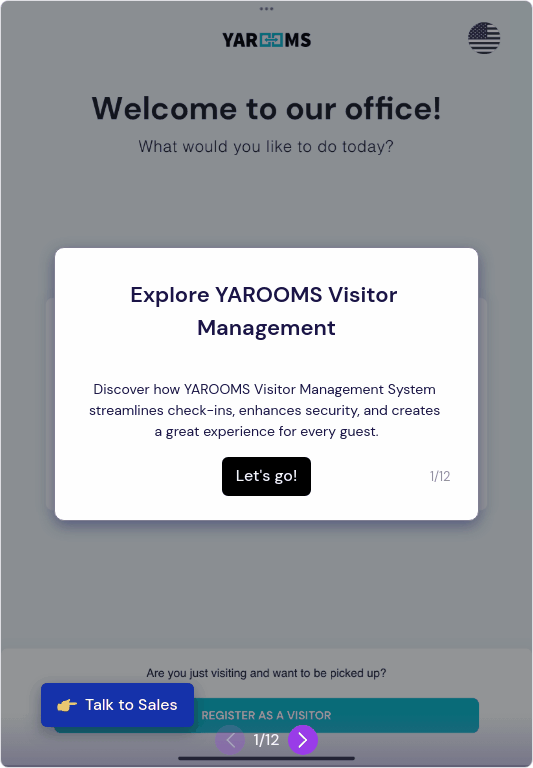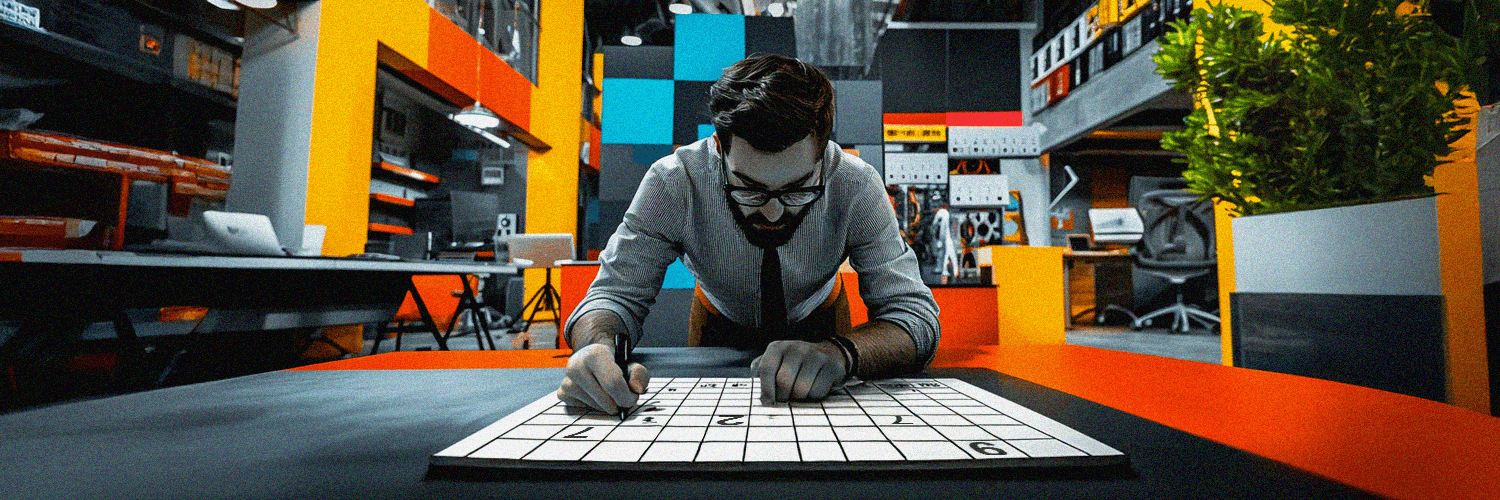Imagine walking into an office building and finding yourself wandering aimlessly through corridors, searching for the right department because no one was available at the front desk. How would you feel? Most likely frustrated and unwelcome.
Now consider the reverse perspective: you work in that office building, and daily, dozens or even hundreds of visitors roam freely through your workspace, interrupting meetings and workflow as they search for their destinations.
The front desk serves as the crucial first point of contact for visitors, clients, and employees alike. It establishes the operational tone of your office and creates a lasting impression on everyone who enters. When managed effectively, it ensures smooth visitor flow, maintains security, and projects professionalism. When neglected, it can undermine your entire organizational image.
TL;DR:
- High visitor volume creates bottlenecks, leading to long wait times and a poor first impression for guests.
- Manual check-in processes slow down operations and introduce errors, inefficiencies, and security vulnerabilities.
- Lack of automated host notifications results in extended visitor wait times, disrupting workflows and frustrating guests.
- Inconsistent communication and poor visitor guidance cause confusion, damaging visitor satisfaction and brand image.
- Receptionists overwhelmed by multitasking struggle to manage visitor check-ins, calls, and deliveries efficiently.
- Weak front desk security exposes organizations to unauthorized access, leading to data breaches and physical safety risks.
- Front desk inefficiencies create poor visitor experiences, hurt your reputation, and lead to lost business opportunities.
- Outdated reception management processes increase security risks, operational costs, and negatively impact customer trust.
6 Common Office Front Desk Problems
Despite the friendly smiles of reception staff, front desk operations face significant challenges daily. Here are six critical issues that can derail even the most well-intentioned reception area:
1. High Volume of Visitors
Managing surges in visitor traffic presents one of the most persistent challenges for front desk personnel. Organizations with unstaffed or poorly managed receptions can experience visitor wait times exceeding 15 minutes, creating frustration and negative first impressions. During peak periods, the overwhelming influx can create bottlenecks, extending wait times and frustrating both visitors and staff. This pressure often compromises the quality of interaction, as receptionists rush through greetings and check-ins to accommodate everyone.
2. Slow Manual Check-in Process
Traditional paper-based visitor registration creates significant inefficiencies at the front desk. The average manual sign-in process takes 2-3 minutes per visitor, while digital solutions reduce this to under 30 seconds. The manual process requires visitors to complete forms while reception staff record and verify information—a time-consuming procedure that leads to queues and unnecessary delays.
Beyond the time factor, manual systems introduce multiple vulnerabilities: handwriting may be illegible, important fields might be overlooked, and paper logs can be misplaced or damaged.

3. Host Notification Process Not in Place
Ineffective communication between the front desk and hosts represents another significant operational weakness. Typically, visitors wait 7-12 minutes for their host to arrive when manual notification systems are used. Without a streamlined notification system, visitors often wait extended periods while reception staff attempt to locate their hosts through phone calls, emails, or physical searches.
4. Lack of Clear Communication and Information Provided to Guests
Front desk personnel must provide clear, accurate information to visitors throughout their experience. A study in the Journal of Facilities Management found that visitors who received comprehensive orientation information reported 68% higher satisfaction with their visit experience. This includes wayfinding guidance, Wi-Fi access details, safety procedures, and other essential information that enhances visitor comfort.
When this communication breaks down, visitors feel neglected and may become frustrated with what they perceive as poor service. The absence of standardized visitor information leads to inconsistent experiences where some guests receive comprehensive guidance while others are left to navigate the premises with minimal assistance.
5. Difficulty Handling Multiple Tasks and Requests Simultaneously
Front desk employees regularly face competing priorities that test their multitasking abilities. From managing visitor check-ins and answering phone calls to coordinating deliveries and responding to employee inquiries—reception staff must balance numerous responsibilities simultaneously. The challenge intensifies during peak periods when multiple visitors arrive simultaneously while phones ring and urgent matters require attention.
6. Security Issues and Unauthorized Access
The front desk serves as the primary gatekeeper for physical access to your organization. Unnauthorized physical access contributes to 44% of all data breaches, making front desk security protocols crucial to overall organizational safety. Without robust visitor verification protocols, unauthorized individuals may gain access to restricted areas, potentially compromising sensitive information, valuable assets, or employee safety.
A recent survey revealed that 63% of organizations had experienced at least one security incident related to improper visitor management within the past three years, highlighting the prevalence of this critical vulnerability.
Impact of Front Desk Problems on Business
Front desk inefficiencies extend far beyond the reception area, creating ripple effects throughout the organization. These impacts manifest in several critical ways:
Poor Visitor Experience and Customer Dissatisfaction
The collective frustrations resulting from front desk challenges directly shape visitor perception of your organization. A study by PwC found that 32% of customers would stop doing business with a brand they loved after just one bad experience. When guests encounter long waits due to inefficient check-in processes, receive inadequate information from overwhelmed staff, or notice obvious security lapses, they form negative impressions that color their entire relationship with your company.
The Harvard Business Review reports that customers who had the best past experiences spend 140% more compared to those who had the poorest experiences—demonstrating the direct financial impact of visitor experience on your business relationships.
Damage to the Reputation and Image of the Company
Your front desk functions as the physical manifestation of your brand, showcasing your organizational values and attention to detail. When reception operations appear disorganized or inefficient, visitors naturally question whether these problems extend to other areas of your business.
The reputational impact often spreads through word-of-mouth and online reviews. Research from BrightLocal indicates that 87% of consumers read online reviews for local businesses, and negative reception experiences increasingly appear in company reviews, potentially reaching far beyond those who directly experience front desk issues.
Lost Business Opportunities
The cumulative effect of front desk problems directly impacts revenue opportunities. Potential clients make judgments about a company's competence based on their first interaction with staff members—often reception personnel. Those who experience disorganized reception processes may question your ability to handle their business professionally.
These impressions matter particularly during competitive bid situations or when prospects are evaluating multiple service providers. Customers are willing to pay up to 16% more for better experiences, suggesting that front desk excellence directly influences revenue potential.

Security Risks
Perhaps most critically, front desk vulnerabilities create significant security exposure for your entire organization. The Ponemon Institute's Cost of Data Breach Study found that the average cost of a data breach reached $4.24 million in 2021, with physical security breaches representing a significant risk vector. Without proper visitor management protocols, unauthorized individuals may gain access to restricted areas, creating risks ranging from information theft to physical safety concerns.
Beyond external threats, poor front desk security creates internal vulnerabilities—sensitive conversations may be overheard, confidential materials might be visible to unauthorized visitors, and employee privacy could be compromised.
Technology Solutions to Office Front Desk Problems
The challenges facing front desk operations require modern solutions that address efficiency, security, and visitor experience simultaneously. Technology offers powerful tools to transform reception areas from potential problem zones into organizational assets:
Visitor Management Systems
Modern visitor management systems (for example, YAROOMS) revolutionize the front desk experience by digitizing and automating traditional check-in processes. According to research by Mordor Intelligence, the visitor management market is growing at a CAGR of 16.7%, reflecting the widespread recognition of these solutions' value. These platforms allow visitors to pre-register online before arrival, creating digital profiles that streamline the check-in experience.
Organizations implementing digital visitor management systems experience up to 70% reduction in check-in time and can significantly improve compliance with security protocols. Visitor management systems automatically capture required visitor information, generate digital badges, and maintain comprehensive digital logs that support security and compliance requirements. Moreover, these systems incorporate automated host notification features that instantly alert employees when their guests arrive.
Case Study: Global Financial Services Firm
A leading financial services organization with offices in 12 countries implemented a comprehensive visitor management system after experiencing security breaches and client complaints about reception inefficiencies. Within three months, the company reported:
- 78% reduction in visitor check-in time
- 93% decrease in security incidents related to unauthorized access
- 64% improvement in visitor satisfaction ratings
- $347,000 annual cost savings from reception staff productivity improvements
The company's Global Security Director noted: "The system paid for itself within four months through efficiency gains alone, but the real value came from improved client experiences and enhanced security compliance."
Digital Reception Assistant Applications
Digital reception assistants complement visitor management systems by providing front desk staff with powerful tools to manage the full spectrum of their responsibilities. These applications consolidate various reception tasks into a single interface, allowing staff to monitor visitor check-ins, package deliveries, meeting schedules, and facility requests simultaneously.
These solutions also enhance the visitor experience by enabling consistent information delivery. Reception staff can access building maps, Wi-Fi credentials, parking details, and other frequently requested information through the platform, ensuring all visitors receive accurate guidance.

Case Study: Technology Campus Innovation Hub
A technology campus hosting multiple startups and established companies implemented a digital reception assistant to manage their complex visitor flow of over 500 daily guests. Their results after six months included:
- 89% reduction in visitor complaints about wayfinding and information accuracy
- 56% decrease in reception staff overtime hours
- 44% improvement in package handling accuracy
- 92% of visiting executives rated the check-in experience as "excellent" compared to 61% pre-implementation
The campus Facility Manager commented: "Our reception team now spends less time on paperwork and more time providing meaningful assistance to visitors. The technology handles routine tasks while our staff focuses on creating exceptional experiences."
Training and Development Programs for Front Desk Staff
Technology solutions deliver maximum value when combined with comprehensive staff training. Companies that invest in comprehensive training enjoy 24% higher profit margins than those with minimal training programs. Effective development programs prepare front desk personnel to leverage digital tools while maintaining the interpersonal skills essential for creating positive first impressions. Training should address both technical competencies with new systems and soft skills like communication, problem-solving, and conflict management.
Comparing Different Visitor Management Approaches
Organizations have several options when implementing visitor management solutions. Here's a comparative analysis of the primary approaches available today:
Traditional Paper-Based Systems vs. Digital Solutions
While paper logbooks and handwritten badges may seem economical, their total cost of ownership often exceeds digital alternatives when considering labor, supplies, and opportunity costs. Front desk staff spend 3.1 hours daily on manual visitor processing with traditional systems—time that could be redirected to higher-value activities.
Digital solutions offer advantages beyond efficiency, including:
|
Feature |
Traditional Paper Systems |
Digital Solutions |
|
Data Security |
Low (visible to all visitors, easily damaged) |
High (encrypted, access-controlled) |
|
Compliance Documentation |
Manual, error-prone |
Automatic, audit-ready |
|
Visitor Experience |
Inconsistent, often frustrating |
Streamlined, professional |
|
Staff Workload |
High administrative burden |
Primarily focused on personal interaction |
|
Emergency Management |
Limited capabilities |
Real-time visitor tracking and notification |
Self-Service Kiosks vs. Staffed Reception
Many organizations debate whether to implement self-service check-in kiosks or maintain traditional staffed reception desks. The optimal approach often combines both elements:
|
Consideration |
Self-Service Kiosks |
Traditional Reception Desk |
Hybrid Approach |
|
Visitor Experience |
Efficient but impersonal |
Personal but potentially slower |
Best of both worlds |
|
Handling Complex Situations |
Limited capabilities |
Strong |
Comprehensive |
|
Staffing Requirements |
Minimal |
Significant |
Moderate |
|
Cost Structure |
Higher upfront, lower ongoing |
Lower upfront, higher ongoing |
Balanced |
|
First Impression |
Modern, tech-forward |
Traditional, relationship-oriented |
Flexible, accommodating |
Cloud-Based vs. On-Premises Solutions
The infrastructure supporting visitor management systems represents another important consideration. Key differences include:
|
Factor |
Cloud-Based Solutions |
On-Premises Solutions |
|
Implementation Timeline |
Days to weeks |
Weeks to months |
|
IT Resource Requirements |
Minimal |
Substantial |
|
Data Security Control |
Provider-managed with SLAs |
Internally controlled |
|
Scalability |
Highly scalable |
May require hardware upgrades |
|
Disaster Recovery |
Built-in redundancy |
Requires separate planning |
|
Cost Structure |
Predictable subscription |
Higher capital expense |
Organizations with strict regulatory requirements or unique security concerns may prefer on-premises solutions despite their higher complexity. However, it is predicted that 90% of workplace tech solutions (including visitor management) implementations will be cloud-based by 2025, reflecting the overwhelming advantages of this approach for most organizations.
Implementing a Digital Visitor Management System
Successfully transitioning to a digital visitor management solution requires careful planning and execution. Here's a comprehensive implementation roadmap based on best practices from organizations that have successfully navigated this change:
Step 1: Assessment and Requirements Gathering
Begin by documenting your current visitor management processes and identifying specific pain points. Gather input from multiple stakeholders including:
- Reception staff who understand day-to-day challenges
- Security personnel concerned with access control
- IT teams responsible for system integration
- Compliance officers with regulatory requirements
- Regular hosts who frequently receive visitors
- Frequent visitors who can provide experience feedback
Compile specific requirements related to:
- Average and peak visitor volumes
- Types of visitors (clients, vendors, job candidates, etc.)
- Security protocols necessary for your industry
- Integration requirements with existing systems
- Compliance and data privacy considerations
- Budget constraints and ROI expectations
Step 2: Solution Selection
With requirements clearly defined, evaluate potential solutions against your specific needs. Consider these key factors:
- User interface simplicity for both visitors and staff
- Mobile capabilities for on-the-go notifications
- Integration capabilities with existing systems
- Customization options for branding and workflows
- Compliance features for your regulatory environment
- Support and training offerings from vendors
- Total cost of ownership including implementation and maintenance
Request demonstrations from multiple vendors and involve stakeholders in the evaluation process. Consider running a limited pilot with 2-3 finalists before making your final selection.
See how the YAROOMS visitor management system works (click the image for the full demo). 👇
Step 3: Implementation Planning
Develop a comprehensive implementation plan that addresses:
- Technical setup including hardware, software, and integrations
- Data migration from existing systems where applicable
- Customization of workflows and notification systems
- Development of new standard operating procedures
- Training requirements for staff and frequent hosts
- Communication strategy for employees and regular visitors
- Go-live timing and contingency planning
Establish clear metrics for success based on your initial pain points, such as average check-in time, security compliance rates, or visitor satisfaction scores.
Step 4: Change Management and Training
The human element of implementation often determines success or failure. Develop a change management approach that includes:
- Early involvement of reception staff in system selection and configuration
- Comprehensive training programs for all user types
- Clear communication about implementation timelines and expectations
- Creation of quick reference guides and support resources
- Identification of "champions" who can support peers during transition
- Recognition of staff who embrace and promote the new system
Research shows that projects with excellent change management are seven times more likely to meet objectives than those with poor change management.
Step 5: Phased Implementation
Rather than switching all processes simultaneously, consider a phased approach:
- Begin with pre-registration for expected visitors while maintaining some manual processes
- Add self-check-in capabilities while keeping staff available for assistance
- Implement automatic notifications to hosts
- Roll out specialized features like NDA management or contractor credentialing
- Introduce visitor analytics and reporting capabilities
This approach allows staff and visitors to adjust gradually while providing opportunities to refine processes based on early feedback.
Step 6: Continuous Improvement
After initial implementation, establish a process for ongoing optimization:
- Regularly review system analytics to identify bottlenecks
- Collect feedback from visitors and staff through brief surveys
- Schedule quarterly reviews of security protocols and compliance
- Stay current with software updates and new feature releases
- Periodically reassess processes against evolving organizational needs

Best Practices for a High-Quality Front Desk Operation
Implementing these best practices creates a foundation for exceptional front desk operations that enhance overall organizational effectiveness:
Hiring the Right Receptionists With Good Customer Service Skills
The individuals staffing your reception area fundamentally shape visitor perceptions of your organization. Reception hires with previous customer service experience often outperform those without such background on visitor satisfaction metrics. Effective hiring begins with recognizing the complex skill set required for front desk success—a combination of technical aptitude, communication abilities, multitasking capabilities, and professional demeanor.
Look for reception candidates who demonstrate genuine interpersonal warmth while maintaining appropriate professional boundaries. Structured interviews that include role-playing scenarios predict front desk performance more accurately than traditional interviews. The ideal front desk staff combine attentiveness to visitor needs with the organizational skills necessary to manage competing priorities.
Establishing Clear Guidelines and Standard Operating Procedures
Consistent front desk operations require well-documented procedures that standardize visitor handling across different staff members and situations. Organizations with documented reception protocols experience fewer security incidents and significantly higher visitor satisfaction scores compared to those without established procedures.
Comprehensive standard operating procedures (SOPs) should address routine scenarios like visitor check-in, package handling, and emergency protocols while providing guidance for unusual situations. These documents create accountability while reducing the cognitive burden on reception staff facing complex decisions. The most effective SOPs incorporate regular updates based on changing organizational needs and lessons learned from operational challenges.
Providing Ongoing Training and Development Opportunities for Receptionists
Front desk excellence requires continuous skill development through structured training opportunities. Effective development programs address both technical competencies with visitor management systems and soft skills like conflict resolution, cross-cultural communication, and stress management.
The most effective training approaches combine formal instruction with mentorship opportunities that allow experienced staff to share practical wisdom with newer team members. Cross-training initiatives that familiarize reception staff with other organizational functions help them provide more comprehensive visitor assistance while creating career development pathways that improve retention and job satisfaction.
Using Technology to Streamline Front Desk Operations
Technology implementation represents perhaps the most transformative opportunity for front desk improvement. Digital visitor management systems, reception assistant applications, and integrated communication tools dramatically enhance operational efficiency while improving security and visitor experience.
When selecting technology solutions, prioritize platforms that integrate with existing organizational systems like calendaring tools, security infrastructure, and communication platforms. The ideal technology stack creates a seamless digital ecosystem that supports front desk operations without creating additional complexity. Regular evaluation of system performance ensures these tools continue meeting evolving organizational needs.
The Future of Front Desk Operations
The reception function continues evolving rapidly as technology advances and organizational expectations shift. Understanding emerging trends helps forward-thinking organizations prepare for tomorrow's front desk requirements:
The integration of artificial intelligence is transforming visitor management through predictive analytics that anticipate peak traffic periods. By 2025, AI will power 95% of customer interactions, including front desk operations—providing automated responses to routine inquiries and intelligent routing of specialized requests. Machine learning algorithms increasingly personalize the visitor experience based on historical preferences and behavioral patterns.
Biometric authentication is supplementing traditional check-in methods, providing enhanced security through facial recognition, fingerprint scanning, or voice identification. Research from MarketsandMarkets projects that the biometric system market will reach $82.9 billion by 2027. These technologies streamline the verification process while creating robust security records that protect organizational assets.
The physical reception space itself is evolving toward a more flexible, welcoming environment that adapts to changing needs. Digital signage provides personalized wayfinding guidance, while self-service kiosks supplement traditional reception staff for routine check-ins. These changes transform reception areas from simple waiting spaces into engagement zones that showcase organizational culture and capabilities.
Most importantly, the front desk function is increasingly integrating with broader workplace experience initiatives that consider the entire visitor journey. Organizations now view reception services as a strategic component of their overall brand experience rather than a purely tactical function. This evolution positions the front desk as a critical touchpoint in comprehensive experience design rather than an isolated operational concern.

Summing It Up
The front desk represents far more than a simple entry point—it functions as the physical embodiment of your organizational brand and values. First impressions form within 7 seconds of initial interaction, making front desk excellence a business imperative rather than a luxury.
By addressing common reception challenges through technology implementation, staff development, and process improvement, you create a powerful competitive advantage that shapes visitor perceptions and supports organizational success. Companies with optimized front desk operations report measurably better outcomes across multiple metrics:
- Higher client retention rates
- Improved employee satisfaction and productivity
- Enhanced security compliance
- Stronger organizational reputation
- Reduced operational costs
- Better visitor experiences
The most effective approach combines digital visitor management systems that streamline operations with carefully selected and trained reception staff who embody your brand values. This integration of technology and human touch creates a reception experience that leaves a positive lasting impression on everyone entering your facility.
Remember that your front desk creates crucial first impressions that visitors carry with them throughout their relationship with your organization. By investing in reception excellence, you're ultimately investing in your company's reputation, security, and business development potential—a strategic decision that delivers measurable returns through enhanced visitor satisfaction and operational efficiency.












